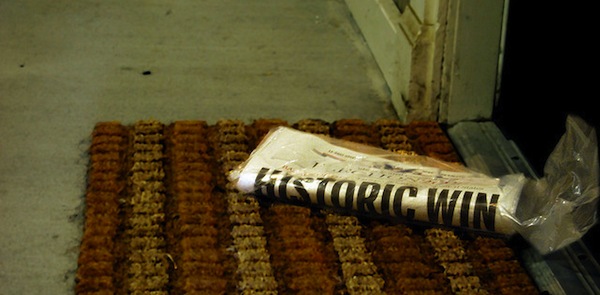

Raise your hand if this scenario sounds familiar: You’re rushing to catch the subway/plane and only moments before boarding do you stop to think about what you’re going to read en route. Suddenly you remember that one great story you saw and wanted to read later. You scramble to launch your favorite reading app only to find you can’t update it in time. The subway/plane door closes, and so does your window of opportunity.
Okay, sure, the commuter’s dilemma falls squarely in the category of first world problems. It’s an annoyance, but an important one given the increasing amount of time we spend with mobile devices and our access-anywhere expectations.
Now two reading apps — News.me a month ago and, as of Saturday, Instapaper — have updated their apps to allow location-based background downloads of new stories. In English: It grabs your newest stories whenever you enter or leave a place. In News.me, you define your home location in the app and whenever you leave those coordinates, it grabs the latest news. Similarly, Instapaper lets you set 10 different locations (home, office, classroom, gym, your favorite bar, etc.) that will trigger updates.
All of this is possible thanks to geofencing, the same idea that pings us when we’re near a restaurant we want to try on Foursquare or shoots us a reminder to pick up laundry detergent when we’re near a market. Geofencing is popular in retail circles because it’s a way of potentially pulling in customers. Instapaper and News.me are putting a new spin on it, an ingenious nod to the old/new reading habit that is being developed. In one way or another, we geofenced our reading in analog ways in the past. You made sure to have a magazine or book with you when you hopped on a plane or subway. Of course, back then, you didn’t have to wait for that latest article from New York to download before you could read it.
Jake Levine, general manager of News.me, told me over email most of the News.me team are subway riders, so they ran into the offline reading problem frequently. Paperboy, the geofencing feature they created, was made by iOS developer Rob Haining, who detailed some of the back-end specifics. Levine said they wanted to adjust the social reading app to the new news routine.
“For some people it starts with waking up, sitting down with a cup of coffee, and flipping through the newspaper. For many, it’s leaving home, commuting via public transportation, and powering up their iPhone,” he said. “Unlike newspapers, which are built for offline consumption, digital applications require some extra effort on the part of the user to work offline.”
These new location-based features are something of a hack. Apple allows a limited number of apps to download content in the background, most notably newspapers and magazines in the Newsstand. Arment writes on the Instapaper blog:
iOS doesn’t yet permit apps like Instapaper to automatically download new content in the background on a regular schedule, but Background Update Locations can get most of the way there for a lot of people. Simply add up to 10 locations that you enter and leave often, and Instapaper will frequently update without manually launching it.
If you own a smartphone, it’s likely you do a fair share of reading on it, which is why news publishers and the universe of reading apps that surround them are trying to find more effective ways of delivering the content you want. Filtration and customization have been big areas of focus, but smarter delivery appears to be the next step.
While these location-based features are designed for readers who find themselves suddenly offline, more granular updating for stories could prove very valuable to all readers. It’s not hard to imagine the possibilities this opens up for mobile devices: top stories in the morning when you leave home, your favorite blogs delivered as you leave for lunch, saved stories updated in time for evening commute. And the best part? It’s all ready when you open the app.
Image by F.C. Photography used under a Creative Commons license.